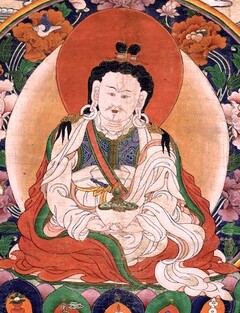Path Integration Song
Four Qualities of Path Integration[1]
A Song by Longsal Nyingpo Expressing His Realization
The holy guru adorns my crown
And suffuses my mind with grace,
Inspiring this song on how all experiences fuel my practice,[2]
And how the nature of things unfolds.[3]
The good and bad I’ve done, like my body’s shadow—
These divine presences and hounding demons—[4]
I have always brought onto the path,
And now, my ethical choices happen naturally.
All the views I have today—
In their perpetual flux—[5]
I have brought onto the path of impermanence,
And I no longer relate to anything as lasting.[6]
Tonight, the stretching shadows—[7]
Like the years in their irredeemable march—[8]
I have brought onto the Lord of Death’s path,
And now, death has become dharmakāya’s friend.
Tonight, my busy speculations
About the qualities of the natural state,
I have brought onto the path of knowing what to do and what to avoid,[9]
And death will be easy, however it comes.
| Translated by Joseph McClellan, 2024.
Bibliography
Tibetan Edition
klong gsal snying po. gter chos klong gsal snying po, vol. 11, 231–232. Kaḥ thog drung pa rin po che, 2014. BDRC W3PD1099
Version: 1.0-20240202
-
The title and stanzas use the phrase lam du khyer, which translates literally to “bring to the path.” This phrase connotes making an ongoing practice of something or continually applying a method. The path referred to can be the general buddhist path with all its doctrines and methods, or it can be qualified as a more specific type of path, as it is below, with, for example, “the path of impermanence" (mi rtag lam). ↩
-
More literally, “How whatever appears helps [me] accomplish my spiritual practice.” ↩
-
“Unfolds” for 'char ba. More literally, “appears,” “dawns,” “shows itself,” or “is experienced.” ↩
-
“Divine presences” renders lhan skye lha. In the present context, the meaning is close to the English idiom "guardian angels," as in divine beings that are always near and have the potential to benefit us. Here they figuratively represent our good karma. These are contrasted with the figurative representation of bad karma: “hounding or accompanying demons” (mnyam 'ong bdud/mnyam por 'ong ba'i bdud). ↩
-
“Perpetual flux” is a concise rendering of rtag tu brten tshul ma nges pa. This phrase could be literally translated as “always indeterminate/uncertain in terms of how they are supported,” figuratively meaning something like “built on shifting sands.” Poetically, Longsal Nyingpo uses the term brten tshul (lit. “way of being supported”) to match the structure of mthong tshul (lit. “way of seeing”) in the first line. ↩
-
In this stanza and the previous stanza, Longsal Nyingpo plays on the word rtag pa (“permanence,” “permanent”). He uses it adverbially (rtag tu), which we have rendered as “continuously” and “in perpetual”; nominally, as “path of impermanence” (mi rtag lam); and adjectively as “relate to… as lasting” (rtag par ‘dzin pa). ↩
-
Stretching shadows” translates the idiom nyi ma’i grib so (“[lengthening] sun shadows”), which is a variant of nub ka’i grib so (“[lengthening] sunset shadows”). As the sun gets closer to the horizon, shadows lengthen, marking the end of another day. ↩
-
“The years in their irredeemable march” is a loose rendering of “irreversible” (bzlog med) + “sexagenary cycle” (rab kyi 'byung ba), which is usually spelled in short form, rab byung. A “sexagenary cycle” refers to the sixty-year cycles that structure the traditional Tibetan calendar. ↩
-
“Path of knowing what to do and what to avoid” translates ’dor len lam, lit. “path of abandoning and accepting.” This is a common term applied to any system of training in which one practices rejecting or not engaging in what is unhelpful while practicing doing what is helpful. In this stanza, Longsal Nyingpo uses the term ironically since the “natural state” is generally said to be beyond the concerns of accepting and rejecting, which is why it is “natural.” Thus, “the path of knowing what to do and what to avoid” here implies that he deals with his mind’s pointless speculations by simply letting the mind be natural. ↩
